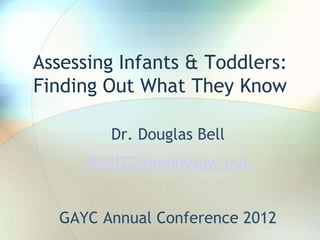
Assessing infants & toddlers
- 1. Assessing Infants & Toddlers: Finding Out What They Know Dr. Douglas Bell dbell22@kennesaw.edu GAYC Annual Conference 2012
- 2. What is Assessment • A process for gathering information for making decisions about Infants & Toddlers • Measurement and appraisal of what children know and can do
- 3. Marty Lipp of Harlem Children’s Zone • Good Teachers are like good parents… • A good parent “does whatever it takes.” There’s no barriers for a parent. A parent doesn’t say “Oh, my job stops here.” If the child needs it, a good parent tries to supply it. And that’s what we do. We’re constantly assessing what we do and looking at how we can do it better.
- 4. Principles That Guide Assessment in ECE • Principle 1: Benefit Children • Principle 2: Be Used for a Specific Purpose • Principle 3: Recognize limitations for young age • Principle 4: Be age appropriate • Principle 5: Be linguistically appropriate • Principle 6: Value Parents
- 5. Assessing Infants & Toddlers • Serves infants/toddlers, families, and caregivers • Should be embedded in the developmental tasks, processes, and content of appropriate educational activities − This reduces the need to get data from isolated tests
- 6. More Principles • Should use multiple sources of information • Should benefit the child and improve learning • Should involve the child and family • Should be fair for all children • Should be authentic • Should be tailored to a specific purpose and be reliable, fair, and valid for that purpose
- 7. NAEYC Requires Assessment • Should be a comprehensive system • Implemented in a thoughtful systematic and documented way • Should connect planning for individual children to assessment • Should balance formal, standardized assessment with informal assessment and direct observation • Should include developmental screening • Results should be shared with those that need to know • Should involve the team • Results should be shared regularly with families
- 8. Overview • Give the big picture of the subject • Explain how all the individual topics fit together Screen Parent System GELS Input Direct Docum Reflect Act Observ ent ation
- 9. Developing a Comprehensive System • Should use a variety of assessments and observations • Over time and across routines/activities • Use standardized/normed formal assessments (screens) • Use informal observations and samples
- 10. Screen • A first look at a child’s development • Identifies the potential for delay • Screening does not provide direct links to curriculum
- 11. Screening Best Practices • Contextually relevant • Functionally appropriate • Relationship enhancing • Observationally based
- 12. Observe • Regularly • With purpose • Separate objective from subjective info • Select the appropriate tools • Observation reveals trends in behavior that allow you to choose among goals to emphasize
- 13. Observation & Assessment Tools • The ounce scale • Anecdotal record • Creative curriculum • Descriptive/interpret for I/T developmental ive continuum • Running record/diary • COR for I/T method • ELAP • Frequency count • Ages & Stages (& S.E.) • Time sampling • DECA • checklist
- 14. Connect it to the Standards • GELS • Conduct periodic observations to check for attainment of the standards • From your observations you can infer what standards to work toward • Remember the standards themselves are not an assessment
- 15. The Process • Document • Reflect • Act
- 16. References • Bentzen, W. (1993). Seeing Young Children: A Guide to Observing and Recording Behavior, 2nd ed. Albany, NY: Delmar. • Cohen, L. & Spensiner, L. (1994). Assessment of Young Children. New York: Longman. • Grace, C. & Shores, E. (1994). The Portfolio and Its Use: Developmentally Appropriate Assessment of Young Children. Little Rock AK: Southern Early Childhood Association. • Gullo, D. (2005). Understanding Assessment and Evaluation in Early Childhood Education, 2nd ed. New York: Teachers College Press. • Helm, J., Beneke, S., & Steinheimer, K. (2007). Windows on Learning: Documenting Young Children’s Work, 2nd ed. New York: Teachers College Press. • Jablon, J., Dombro, A., & Dichtelmiller, M. (1999). The Power of Observation. Washington DC: Teaching Strategies Inc. • Martin, S. (2004). Take a Look: Observation and Portfolio Assessment in Early Childhood, 3rd ed. Toronto: Pearson. • McAfee, O., & Leong, D. (2002). Assessing and Guiding Young Children’s Development and Learning, 3rd ed. Boston, MA: Pearson. • Meisels, S. & Atkins-Burnett, S. (2005). Developmental Screening in Early Childhood: A Guide, 5th ed. Washington DC: National Association for the Education of Young Children. • Mindes, G. (1996). Assessing Young Children, 3rd ed. Upper Saddle River, NJ: Pearson. • Puckett, M. & Black, J. (2008). Meaningful Assessments of the Young Child: Celebrating Development and Learning, 3rd ed. Upper Saddle River, NJ: Pearson. • Wortham, S. (2001). Assessment in Early Childhood Education, 3rd ed. Upper Saddle River, NJ: Merrill Prentice Hall.